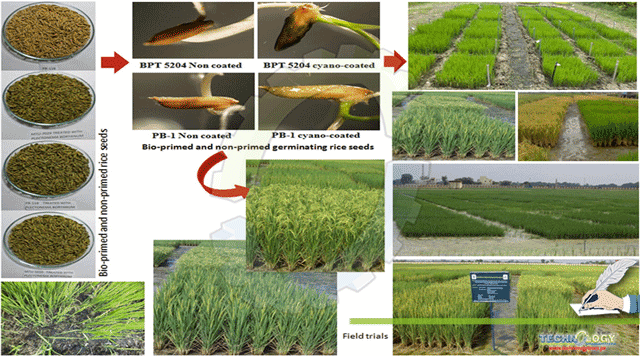Biopriming refers to the procedure of biological seed treatment which involves seed hydration followed by inoculation with useful microorganisms.It adds improvement to seeds in terms of viability,vigor indices,and germination.

By Uzma Nasrullah
Bio-priming is a new technique of seed treatment that integrates biological (inoculation of seed with beneficial organism to protect seed) and physiological aspects (seed hydration) of disease control. It is recently used as an alternative method for controlling many seed- and soil-borne pathogens. It is an ecological approach using selected fungal antagonists against the soil- and seed-borne pathogens. Biological seed treatments may provide an alternative to chemical control. Seed priming, osmo-priming and solid matrix priming were used commercially in many horticultural crops, as a tool to increase speed and uniformity of germination and improve final stand. However, if seeds are infected or contaminated with pathogens, fungal growth can be enhanced during priming, thus resulting in undesirable effects on plants. Therefore, seed priming alone or in combination with low dosage of fungicides and/or biocontrol agents has been used to improve the rate and uniformity emergence of seed and reduce damping-off disease.
Seed biopriming with Agriculturally important microorganisms
Seed is a vital source for sustained growth in agriculture since ninety percent of the food crops are grown from seed. The importance of healthy seeds in crop production is key factor especially in developing countries like India where demand of food supply for ever increasing population must be achieved. The seed and soil borne diseases impose devastating consequences on crop production. The chemical control via seed treatment has its certain limitations including high cost of chemical products, effects on non-target organism, selectivity, chances of pest resistance, contamination of food, toxicity to plants. Seed treatments with bioinoculants for managing seed and soil borne diseases provide an excellent alternative to harmful chemical. Even as seed treatment with bioagents can be effective, it must be known that they differ by utilizing living microorganism from chemical seed treatments.Various microorganisms used as seed dressers are potential rhizosphere colonizer and help plant growth and health beyond the germination and seedling emergence stage..
Seed biopriming mediated enhancement of nutrient use efficiency
Microbes play vital role in soil nutrient cycling through mobilization and uptake. Soil health and nutrient pool status depend on function and structure on microbial communities residing in it. Soil microbial communities are key component of biogeochemical cycling of materials and have an effect on composition,concentration and availability of soil nutrient.Most of the fertilizers applied to the soil are not available to the plants and wasted through run off and leaching. Low efficient use of fertilizers is not only responsible for higher cost of production, but also caused the serious environmental problems such as soil acidification, ground water contamination and N2O emission. Therefore, maintaining agricultural productivity in such a way that minimizes the harmful effects of fertilizers on environment is need of the hour.Various techniques have been advocated to increase the nutrient use efficiency. Incorporation of various sustainable agricultural practices, including crop rotation, fertilizer use rationalization, establishment of ground cover, green manuring and burial of crop residues are widely recommended. Microorganisms are also reported to enhance the nutrient use efficiency.The presence of microorganisms in rhizosphere influences the nutrient availability to the plants.
Seed biopriming with plant growth promoting rhizobacteria
Beneficial microbes are applied to the soil and plant tissues directly or through seed inoculation, whereas soil application is preferred when there is risk of inhibitors or antagonistic microbes on the plant tissues. Insufficient survival of the microorganisms, hindrance in application of fungicides to the seeds and exposure to heat and sunlight in subsequent seed storage in conventional inoculation methods force to explore appropriate and efficient bacterial application method. Seed priming, where seeds are hydrated to activate metabolism without actual germination followed by drying, increases the germination, stand establishment and stress tolerance in different crops. Seed priming with living bacterial inoculum is termed as biopriming that involves the application of plant growth promoting rhizobacteria. It increases speed and uniformity of germination; also ensures rapid, uniform and high establishment of crops; and hence improves harvest quality and yield. Seed biopriming allows the bacteria to enter/adhere the seeds and also acclimatization of bacteria in the prevalent conditions.
Author : Uzma Nasrullah University of Agriculture Faislabad